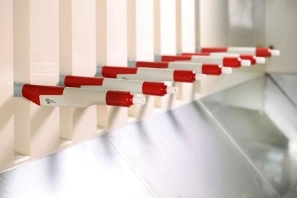Content Menu
● Understanding Electrostatic Spray Guns
>> What Are Electrostatic Spray Guns?
>> Advantages in High-Volume Environments
● Preparation for Electrostatic Spraying
>> Equipment Setup and Maintenance
>> Workpiece Preparation
● Optimizing Electrostatic Spray Parameters
>> Voltage and Charge Settings
>> Spray Distance and Angle
>> Air Pressure and Flow
● Paint and Material Selection
>> Choosing Compatible Paints
>> Mixing and Filtering Paints Properly
● Production Line Integration
>> Conveyor and Grounding Systems
>> Environmental Controls
● Health and Safety Considerations
>> Operator Training and Protection
>> Equipment Safety Features
● Troubleshooting Common Issues
>> Orange Peel and Surface Defects
>> Poor Coverage and Excessive Overspray
>> Electrical Arcing
● Innovation and Future Trends
>> Automation and Robotics
>> Advanced Material Formulations
>> Smart Monitoring Systems
● Frequently Asked Questions
>> What types of paints work best with electrostatic spray guns?
>> How important is grounding in electrostatic spraying?
>> Can electrostatic spray guns be used on plastic parts?
>> What maintenance routines are recommended for spray guns?
>> How do environmental factors affect electrostatic spray quality?
Electrostatic spray guns have revolutionized the painting and coating industries by enabling efficient, uniform, and cost-effective application of paints and coatings, especially in high-volume production environments. Their ability to improve transfer efficiency and reduce waste makes them indispensable in modern manufacturing. This article explores best practices for maximizing the benefits of electrostatic spray guns while maintaining consistent quality and efficiency in high-volume production.

Understanding Electrostatic Spray Guns
What Are Electrostatic Spray Guns?
Electrostatic spray guns use an electric charge to atomize paint particles and attract them to the grounded workpiece. This process increases the transfer efficiency, meaning more paint reaches the parts and less is wasted in the air or on surrounding surfaces. Typical uses include automotive parts, appliances, and industrial components.
Advantages in High-Volume Environments
Electrostatic spray systems excel in high-volume production primarily due to:
- Reduced paint consumption
- Faster coating times
- Uniform coverage
- Reduced overspray and environmental pollution
These benefits combine to lower costs and speed up production cycles.
Preparation for Electrostatic Spraying
Equipment Setup and Maintenance
Proper setup and maintenance of equipment are critical for effective electrostatic spraying. Components include:
- Spray gun: Check for proper charging and atomization
- Power supply: Ensure consistent voltage and grounding
- Air supply: Maintain stable pressure and quality
- Paint delivery system: Use compatible paints and filters
Regular inspection and maintenance reduce downtime and ensure consistent spray performance.
Workpiece Preparation
Surface preparation significantly affects coating quality. Best practices include:
- Cleaning surfaces thoroughly to remove oils, dirt, and dust
- Using abrasive blasting or chemical treatments when necessary
- Ensuring the workpiece is properly grounded to avoid charge buildup
Good surface preparation facilitates paint adhesion and reduces defects such as fisheyes and runs.
Optimizing Electrostatic Spray Parameters
Voltage and Charge Settings
The voltage setting on the spray gun must be optimized to balance atomization and attraction force. Too high voltage can lead to arcing and overspray, while too low voltage reduces transfer efficiency. Adjusting the voltage depends on:
- Paint type and viscosity
- Environment humidity and temperature
- Workpiece material and geometry
Spray Distance and Angle
Maintaining the correct spray distance (typically 6 to 12 inches) and angle ensures even paint deposition and reduces overspray. Angling the gun perpendicular or slightly tilted toward the part surface helps achieve consistent coverage without defects.
Air Pressure and Flow
Optimal compressed air pressure is essential for proper atomization. Too high or low air pressure negatively impacts droplet size and spray pattern. Typical pressure for electrostatic spray ranges from 20 to 60 psi, adjustable per paint type.
Paint and Material Selection
Choosing Compatible Paints
Not all paints are suitable for electrostatic spraying. Conduct tests to confirm:
- Paint conductivity
- Viscosity suitable for atomization
- Compatibility with electrostatic charging
Powder coatings and waterborne paints are commonly used due to their excellent electrostatic properties.
Mixing and Filtering Paints Properly
Consistent paint quality is vital:
- Use recommended thinning ratios to maintain viscosity
- Filter paint through fine strainers to remove lumps and impurities
- Mix paint thoroughly for uniform color and consistency
These measures prevent clogging and ensure smooth spraying.
Production Line Integration
Conveyor and Grounding Systems
Integrating electrostatic spray guns on automated conveyor systems enhances productivity. Proper grounding of conveyors and racks is necessary to direct charged paint particles efficiently, preventing defects caused by static discharge.
Environmental Controls
Maintaining environmental conditions optimizes performance:
- Control humidity and temperature to minimize paint drying issues
- Use booths with proper ventilation to remove overspray and fumes
- Implement dust control measures to prevent contamination
A controlled environment supports consistent finish quality.
Health and Safety Considerations
Operator Training and Protection
Operators must be trained on:
- Safe operation of electrostatic equipment
- Proper grounding and handling procedures
- Use of personal protective equipment (PPE) such as respirators and gloves
Proper training reduces the risk of electric shock, inhalation hazards, and accidents.
Equipment Safety Features
Regularly inspect safety features like:
- Interlocks and grounding monitors
- Emergency shut-offs
- Insulation of high-voltage components
These features protect both workers and equipment.
Troubleshooting Common Issues
Orange Peel and Surface Defects
Orange peel texture or rough surfaces can result from:
- Incorrect spray distance or angle
- Improper voltage or air pressure settings
- Incompatible paint viscosity
Adjusting parameters and improving surface preparation can resolve these issues.
Poor Coverage and Excessive Overspray
Caused by:
- Low transfer efficiency from poor grounding or wrong voltage
- Excessive spray distance or poor gun handling
- Using incompatible paint types
Regular system checks and operator adjustments improve coverage.
Electrical Arcing
Dangerous arcing may occur when:
- Voltage is set too high
- Workpiece is improperly grounded
- Moisture or dust causes conductive paths
Ensure correct settings and clean work areas to prevent arcing.
Innovation and Future Trends
Automation and Robotics
Robotic spray systems equipped with electrostatic guns offer high precision, repeatability, and speed, reducing human error and improving production throughput.
Advanced Material Formulations
Developments in paint chemistry continue to improve conductivity, adhesion, and environmental safety, expanding electrostatic spraying applications.
Smart Monitoring Systems
Real-time sensors and AI-powered monitoring can optimize spray parameters dynamically, minimizing waste and defects.
Frequently Asked Questions
What types of paints work best with electrostatic spray guns?
Conductive paints such as powder coatings and waterborne paints are ideal due to their ability to carry an electric charge effectively. Solvent-based paints can also work if properly formulated.
How important is grounding in electrostatic spraying?
Grounding the workpiece is crucial to attract charged paint particles and prevent charge buildup, which can cause defects and safety hazards.
Can electrostatic spray guns be used on plastic parts?
Yes, but the plastic must be conductive or coated with a conductive primer to allow proper attraction of charged paint particles.
What maintenance routines are recommended for spray guns?
Cleaning after each use, inspecting for wear or clogging, and checking electrical connections regularly are key practices to maintain consistent performance.
How do environmental factors affect electrostatic spray quality?
Humidity and temperature influence paint drying times and charge behavior. Stable environmental conditions lead to more consistent finishing results.
Hot Tags: China, Global, OEM, private label, manufacturers, factory, suppliers, manufacturing company









































 .
. 